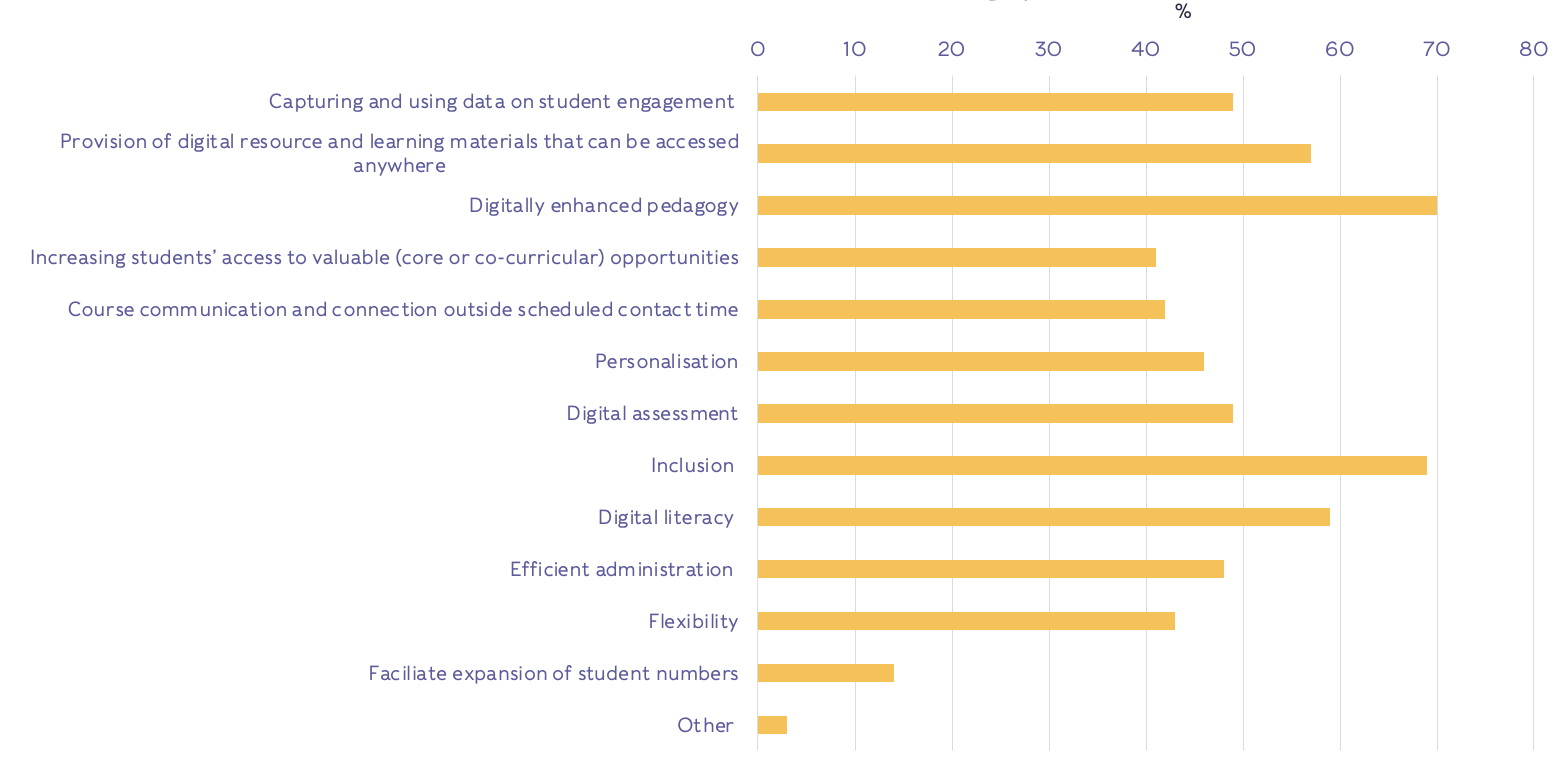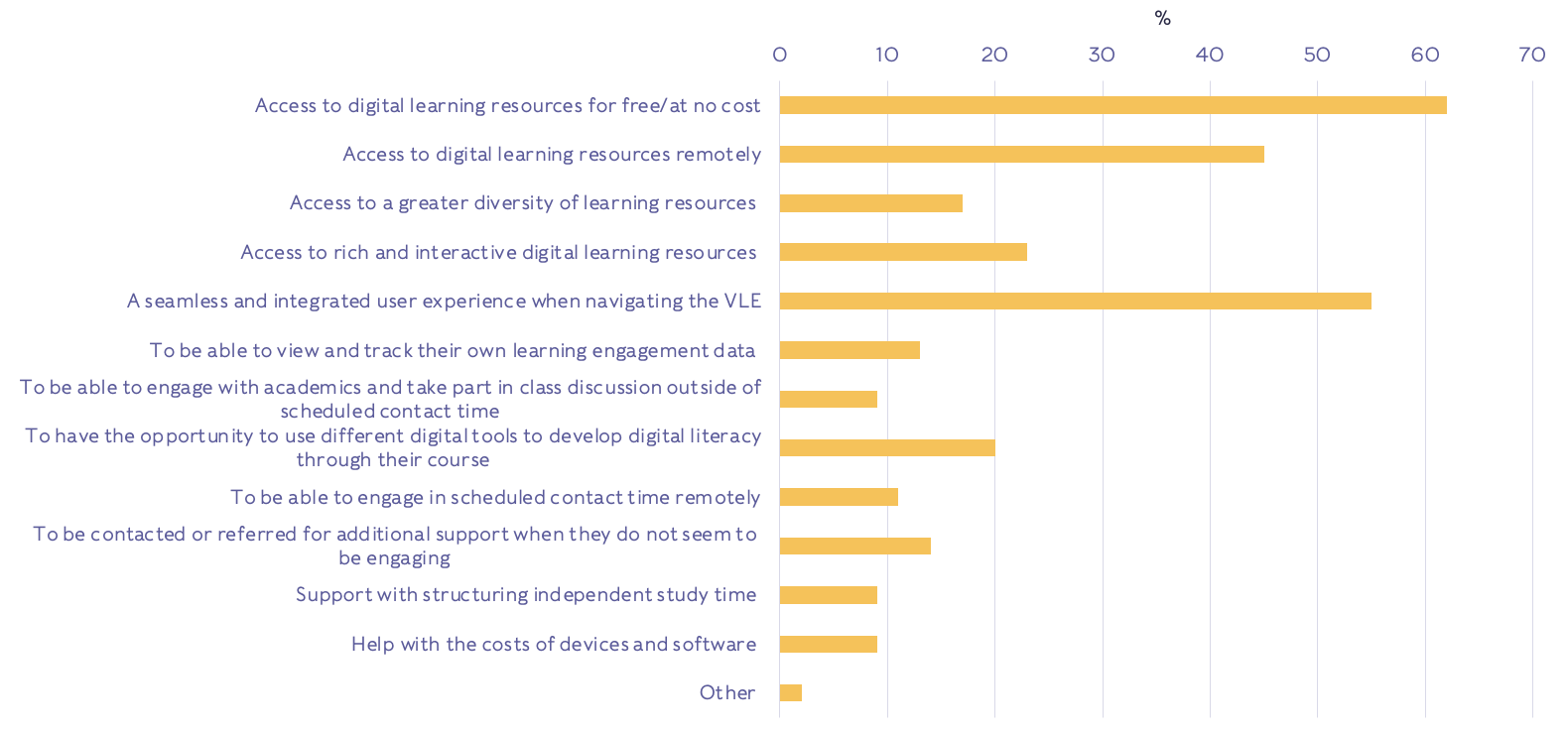Post-Covid, the need for universities to do things digitally hasn’t gone away – but rather than addressing the immediate pressures of the need to deliver remote learning at pace, universities have been grappling with the question of how to deploy technology to support their longer term learning, teaching, and student success strategies.
There are a range of challenges that come with offering higher education at the current scale and to the current diversity of students, particularly providing inclusive learning environments for the various axes of student diversity, sustaining student engagement both in the classroom and in their independent learning, student employability, and student wellbeing. All of these things are relatively straightforward to achieve on a small scale, resource-rich learning environment in which student needs are reasonably predictable – but this is not the world of contemporary higher education.
Technology can serve a wide range of ends – expanding access to learning resources, offering new tools for engagement, underpinning a more coherent and streamlined student journey, providing data to inform decisions, and enhanced connection and communication – as well as a long tail of things that are either cool and fun, or functional and necessary (or occasionally, both).
But in making technology part of the solution universities must also ask some searching questions: about the degree of digital capability required of staff and students; about what “hybrid” work and learning should look like and why; about the interaction of the digital and physical estate; and, crucially, about the nature of the spaces available for being critical about technology adoption, and how the conversation about technology moves forward.
Hearing from educators
In the spring of 2023 Wonkhe and Kortext conducted a survey of 463 academic and teaching and learning support professionals in UK universities. Around half (51 per cent) of respondents were learning and teaching professionals, 38 per cent were academics (with a broad disciplinary spread), and 11 per cent were members of senior teams. 42 per cent were from pre-92 universities, 45 per cent from post-92 universities, and 11 per cent from independent, or specialist institutions or further education colleges. Qualitative responses indicated that a good number of respondents have some degree of personal responsibility for technology enhanced learning or related institutional or disciplinary activity.
Rather than capturing a nationally representative picture of opinion or practice, the survey was intended to collate individual views and insights to inform understanding of how the conversation among educators about the role of technology in learning, teaching, and student support is evolving post-Covid.
Most – 79 per cent – of the respondents to the survey, considered themselves to be enthusiasts for the development of digital capabilities to enhance learning, teaching, and student support, rating themselves at 4 or 5 on a five-point scale.
When asked why, answers included enabling more accessible inclusive learning, the potential for innovation (including productivity and efficiency in work and greater flexibility in learning), the prospect of engaging and enthusing students in learning in new ways, the importance of digital skills for graduate employment, and a general sense that embracing digital technology orients individuals and organisations towards the future.
I believe it’s one of the most important aspects of providing high quality teaching, learning, and assessment. We have a duty to improve the digital literacy of our students to better prepare them to thrive in a digital world.
Learning and teaching professional, FE college
I have always been keen to ensure that we provide ways for students to engage, whatever their circumstances. Effective use of digital platforms/software and also providing such to students is a way to do this.
Academic, post-92 institution
Some explicitly tempered their enthusiasm with the caveat that they are less comfortable with a technology-led approach:
I’m strongly committed, but wary of digital evangelists who sometimes give the impression that developments in this area are the only ones that matter in terms of education and student support.
Learning and teaching professional, pre-92 institution
We asked what respondents’ top three priorities as educators were – respondents could select as many from the offered options as they wanted. Digitally enhanced pedagogy was the most popular, selected by 70 per cent of respondents. Inclusion (69 per cent) and developing digital literacy (59 per cent) were also popular choices. These priorities chime closely with why respondents are enthusiastic about technology – to engage students in learning, to make learning more accessible and inclusive, and to prepare students for their future lives and careers.

Chart: Thinking about the various uses of digital technology in the context of learning, teaching and student academic support – which of the below are your key priorities as an educator? (%) Labels have been edited for readability – in the survey we gave examples of the concepts.
We also asked what, in respondents’ judgement, students most need from digital technologies to support their engagement with learning and academic development. In this instance we forced a choice of three. There were three clear priorities: access to digital learning resources for free (62 per cent); a seamless and integrated user experience when navigating the virtual learning environment (55 per cent); and access to digital learning resources remotely (45 per cent).

Chart: In your judgement, what do you think your students most need from digital technologies to support their engagement with learning and academic development? (%) Select up to three.
These findings suggest that while educators are thinking about how to design engaging and inclusive learning experiences, students’ ability to access learning resources and have a positive user experience is a vital foundational consideration – the hygiene factors that enable the aspirations of educators to be realised.
Going beyond digital in learning and teaching
Danielle George, associate vice president blended and flexible learning, University of Manchester, with Simon Thomson, Jane Mooney, and the UoM flexible learning programme team
Digital technologies for learning and teaching have become a key component of any university’s (digital) infrastructure and yet the evolving nature of “digital” sometimes feels like we are always playing catchup. Over the past few years the focus has rightly shifted away from “training” on the specific tools we use to a much more nuanced approach to how they are being used and by whom.
Understanding and developing the digital capabilities of both our staff and students has been identified as a critical factor of success and is a key part of the flexible learning programme at the University of Manchester as we set out to: “create lifelong flexible learning that is inclusive, accessible and international, preparing our graduates for an increasingly digital world that demands agility, creativity, and digital proficiency.”
This flexibility requires us to think more deeply about the modes through which we teach and the way in which we use digital tools to design, develop, facilitate and access learning. However, as history has shown, tools alone will not bring the successes we seek and so significant effort is being placed on building staff and student confidence and capability in using new and existing digital tools to maximise success. We need to build this confidence and capability in such a way as to foster an environment where staff and students can adapt to new technologies and identify ways in which they can support their pedagogic approaches.
Ultimately, we should be seeking an outcome where we no longer need to specify “digital” as a separate term and that it’s all just learning, making use of physical and digital infrastructure to provide learning experiences to the broadest range of students. This post-digital vision can only be achieved through the seamless integration of digital tools and the increased capabilities of our staff and students.
How can technology providers best meet the needs of educators and students?
James Gray, co-founder and chief executive, Kortext
In a world where students need to be able to access learning resources on demand and study at any time, from anywhere, on a consistent, user-friendly and accessible interface, universities need to work out how to enable and support that.
Universities are large and complex organisations, and since the invention of the printing press they have delivered their mission in almost the same way. As the world has changed – the nature of the job market, the nature of the delivery of content, and the utilisation of technology means that universities also need to change, but I’m under no illusion that that change process can be very complicated.
While there’s endless sources of insight about change management out there, there is something quite distinctive about how universities have traditionally been constituted that can push against getting effective outcomes. Sometimes procurement processes don’t align with strategic objectives; even the way budgets are distributed, with different groups working towards similar objectives but with devolved pots of money and that don’t communicate effectively around a common approach and that are not cross-referenced, means the end goal is often hard to align behind.
Where it works best is where institutions really know what they want to achieve and there’s a cross-institutional group driving that agenda forward, with strong leadership – that’s a really good foundation for forging a productive partnership with technology providers.
The Wonkhe/Kortext survey finds that inclusion, digital literacy, and leveraging the benefits of technology to improve pedagogy and engage students are priorities for educators. The theme of building student confidence with independent learning also came through strongly – demonstrating that it’s not a question of simply providing access to resources and reducing costs for students, but about ensuring that students are academically supported and engaged as well outside the classroom, as inside it.
The survey found strong support among the educators who responded for increasing digitisation of learning resources, including ebooks and etextbooks, with 80 per cent of respondents expressing support at four or five on a five-point scale. There was also a clear majority (64 per cent) in favour of using student engagement data for analytics to inform student academic support and enhance pedagogy.
We have recently undergone our own journey of digital transformation, working with our global partner Microsoft to make it possible for us to achieve things at scale that we have never been able to do before: index content at scale and design a sophisticated data warehouse that can feed into GPT4 generative AI technology to create AI tools embedded in the platform that can support student engagement and learning.
Our new Kortext Premium Work Space enables learners and academics to use these study tools on their own content such as course guides, module handbooks, academic power points as well as library resources. Users can then engage with these resources in new ways creating notes and references and self-test – making working hard easier for students and saving time and effort for academics.The academics and students we have shared some of our new functionality with have been genuinely excited to see what the platform can do.
Harnessed together effectively, these technologies of digitisation, data analytics, and generative AI can create the conditions for students to learn wherever they are and give educators insight about students’ learning engagement on a scale that has never been seen before. But the potential of a platform like Kortext is most fully realised when it acts as the enabling mechanism for the course construct created by educators. Good pedagogy and a well-designed student journey frame the intended learning processes and outcomes; Kortext helps make that possible.
This article is published in association with Kortext as part of a suite on the theme of universities deploying technology for learning, teaching, and student success. You can download the full Setting the curve report of the survey findings and leaders’ insight over on Kortext’s website here. Find out more and book your demo for Kortext Premium here.















